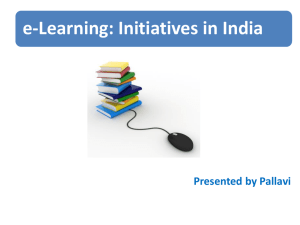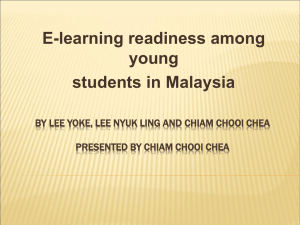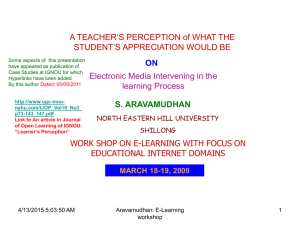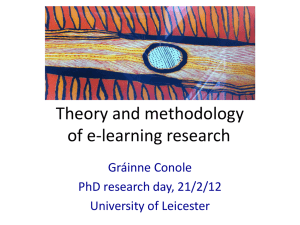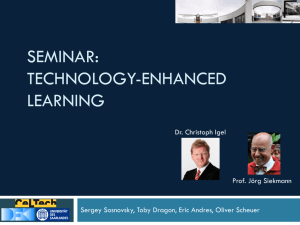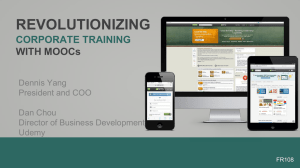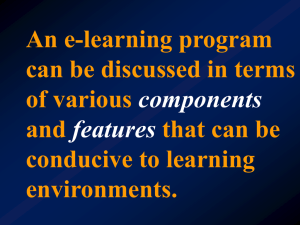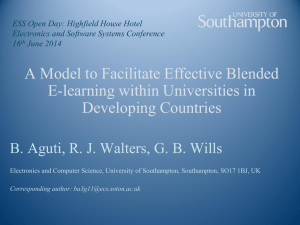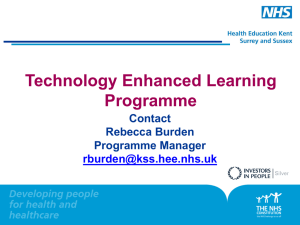Document
advertisement
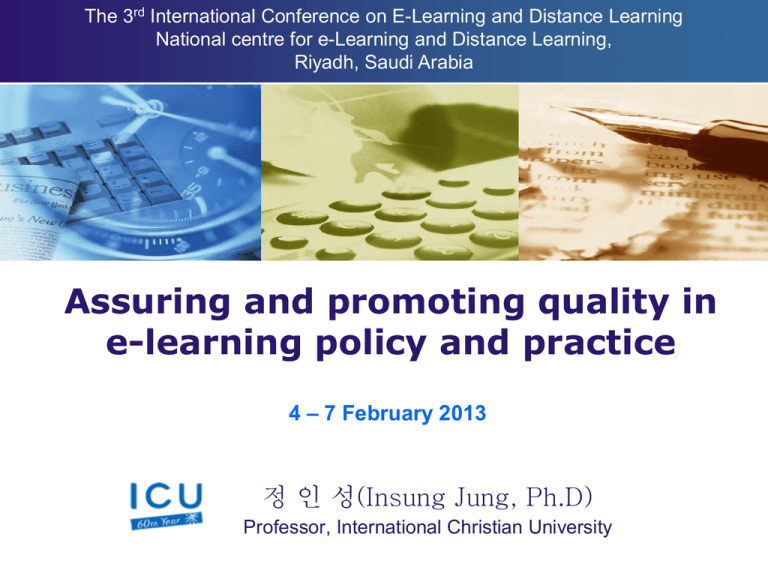
The 3rd International Conference on E-Learning and Distance Learning National centre for e-Learning and Distance Learning, Riyadh, Saudi Arabia Assuring and promoting quality in e-learning policy and practice 4 – 7 February 2013 정 인 성(Insung Jung, Ph.D) Professor, International Christian University TABLE OF CONTENTS Background Approaches to QA in e-learning Examples of QA standards QA Policy Framework Conclusion Background E-learning ---- Enhanced Learning Background Enhanced Learning • • • • • • • • • • Connectivity & 24/7 access to learning resources Greater choice over the time, place and pace of study Alternative modes of study Knowledge-sharing and co-authoring Reflection and planning in personal learning spaces Rapid feedback on formative assessments More active learning Participation Learning by discovery in virtual worlds Development of skills in a digital age. Quality Assurance (QA) TABLE OF CONTENTS Background Approaches to QA in e-learning Examples of QA standards QA Policy Framework Conclusion Approaches to QA 5 ways of QA approaches 1) Quality as conforming to the standards set for conventional education. 2) Quality as fitness for purpose. 3) Quality as meeting customers’ needs. 4) Quality as continuous improvement. 5) Quality as compliance with national/international standards and requirements. Approaches to QA Conforming to standards set for conventional education. Measures quality by applying the same standards set for conventional institutions’ management, teaching and learning, resources and outcomes. Example: Singapore, UK, and Japan Benefits • Ensure parity of esteem for e-learning institutions & awards granted to graduates. • Demonstrate the success of e-learning Weakness • No account of unique and value-adding features of e-learning Approaches to QA Quality as fitness for purpose Focuses on the extent to which e-learning institutions or programs accomplish purposes or missions. Example: India and some European QA framework Benefits • Recognize the distinctive features of each program • Allows for more flexibility • Promotes more innovative actions Weakness • Difficult to compare the quality of e-learning with that of conventional education and other e-learning Institutions. Approaches to QA Quality as meeting customers’ needs Define quality in terms of customer satisfaction Example: ISO9001 Benefits • Evaluation from diverse audiences • Measure quality of educational services, and effectiveness/experience Weakness • Conflicts between individual students’ needs or between different stakeholders’ needs • Not considering students as contributors Approaches to QA Quality as continuous improvement Fosters continuous improvement through cyclical system/ evidence-based practice Example: Institutions that values research, evaluation, reflective and scholarly practice Benefits • All members collaborate during the QA process Weakness • Findings do not necessarily lead to solutions on how to improve/ change QA practices. • Require resources, efforts and competencies. Approaches to QA Quality as compliance with international standards International accreditation ensures institutions measure up to rigorous international standards Benefits • Students’ confidence in programs/courses • Institutions, develop strong review processes Weakness • Requires extensive quantitative input data • Ignores qualitative aspects. • Conflicts of needs TABLE OF CONTENTS Background Approaches to QA in e-learning Examples of QA standards QA Policy Framework Conclusion Examples of QA standards The European Universities Quality in e-Learning (UNIQUe) QA at institutional level Evaluates 10 areas across 3 domains Resources • Learning • Students • Faculty • Equipment Processes • Quality of the Office • IPR Management • HR Development &Services Context /Institution • Commitment to Innovation • Institutional Standing • Openness Examples of QA standards The European Universities Quality in e-Learning (UNIQUe) Six Stages Inquiry Application Eligibility SelfAssess ment Peer Review 18 month after accreditation: Report on its progress and Seek re-accreditation after 3 years. Awarding Body Examples of QA standards The Quality Matters Rubric for Higher Education 1 Course Overview and Introduction SIMPLE for wide use 8 General Standards 41 specific standards 2 Learning Objectives (Competencies) 3 Assessment and Measurement 4 Instructional Materials 5 Learner Interaction and Engagement 6 Course Technology 7 Learner Support 8 Accessibility Examples of QA standards KERIS: e-learning accreditation criteria Evaluates & Accredits programs Focus on the quality of e-learning content 4 Steps (Accreditation Process) Application for accreditation Preparation fo r evaluation Evaluation Accreditatio n decision Examples of QA standards KERIS: e-learning accreditation criteria 9 Domain, 20 Criteria 1. Needs analysis 2. Instructional design 3. Learning content 4. Teaching-Learning strategy 5. Interaction Learner & Learning Content 6. Support system 7. Assessment 8. Ethical standards 9. Copyright Important Criteria Examples of QA standards Commonalities in QA criteria and procedures Common QA criteria cover Input, Process & Output Variables Vision, policymaking and Governance, Technology management & provision and planning administration infrastructure Teaching and Learner Faculty and learning support staff Finance Collaboration & partnership Curriculum & course development Evaluation and assessment Learning outputs, outco mes & impacts Learning resources Examples of QA standards Common procedures QA or Accreditation External review or peer review Self-assessment, self-study or selfevaluation Decision TABLE OF CONTENTS Background Approaches to QA in e-learning Examples of QA standards QA Policy Framework Conclusion QA Policy Framework At National Level No distinction between QA in e-learning and conventional education Consider the unique features of e-learning in each country’s societal and cultural contexts Learners’ needs and perceptions of quality Aligned with regional and/or international QA frameworks. QA Policy Framework At Institutional Level Firmly linked to national QA policy framework Linked with the regional and/or international QA policy frameworks (cross-border education) Engage key stakeholders Promote a culture of quality - Coordinate QA activities QA Policy Framework Regional QA Framework International QA Framework National QA Policy Framework for Higher Education Integrated QA policies for conventional and e-learning QA standards for conventional higher education QA standards for e-learning Institutional QA Policy Framework Top management QA coordinating body QA planning Promoting a quality culture Stakeholder requirements / Societal needs Internal QA standards Stakeholder satisfaction / Outcomes Concerns of stakeholders Learners Providers/Assessors Employers/Graduates TABLE OF CONTENTS Background Approaches to QA in e-learning Examples of QA standards QA Policy Framework Conclusion Conclusion Positioning QA in the pursuit of self-improvement and public accountability of e-learning institutions Considering distinctive features of e-learning in Q A frameworks or during evaluation processes Commonalities that connect the different QA efforts in various elearning contexts linking QA results to direct or indirect funding, l evels of autonomy, or other supports adopting both internal and external assessments making QA results public. Conclusion Value Collective Effort Idea A Culture of Quality Satisfaction Belief Selfimprovement Accountability QA is no longer an additional element to but essential to institutional policy development and implementation References COL (2009). Quality assurance toolkit: Distance higher education institutions and programmes. Vancouver: The Commonwealth of Learning. Retrieved fromhttp://www.col.org/PublicationDocuments/pub_HE_QA_Toolkit_web.pdf Harvey, L. (2002). The end of quality? Quality in Higher Education, 8(1), 5-22. Jung, I.S., & Latchem, C. (2007). Assuring quality in Asian open and distance learning. Open Learning, 22(3), 235250. Jung, I.S., & Latchem, C. (Eds.) (2011). Quality assurance and accreditation in distance education and e-learning: Models, policies and research. New York and London: Routledge. Jung, I.S., Wong, T.M., Li, C., Baigaltugs, S., & Belawati, T. (2011). Quality assurance in Asian distance education: Diverse approaches and common culture. The International Review Of Research In Open And Distance Learning, 12(6), 63-83. Retrieved from http://www.irrodl.org/index.php/irrodl/article/view/991/1953 Saito, T. (2009). Quality assurance of distance education/e-learning. Report of Project Group 3: Asia Pacific Quality Network. Retrieved fromhttp://www.apqn.org/files/virtual_library/project_reports/pg3_project_report_february_2009.pdf Stella, A., & Gnanam, A. (2004). Quality assurance in distance education: The challenges to be addressed. Journal of Higher Education, 47(2), 143-160. Questions Thank You! (شكرا (جزيال Email: isjung@icu.ac.jp

